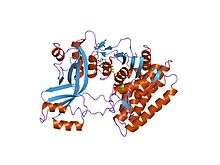ACT domain
| ACT | |||||||||
|---|---|---|---|---|---|---|---|---|---|
 Crystal structure of E. coli aspartokinase iii in complex with aspartate and adp (r-state) | |||||||||
| Identifiers | |||||||||
| Symbol | ACT | ||||||||
| Pfam | PF01842 | ||||||||
| Pfam clan | CL0070 | ||||||||
| InterPro | IPR002912 | ||||||||
| SCOP | 1psd | ||||||||
| SUPERFAMILY | 1psd | ||||||||
| CDD | cd02116 | ||||||||
| |||||||||
In molecular biology, the ACT domain is a protein domain that is found in a variety of proteins involved in metabolism. ACT domains are linked to a wide range of metabolic enzymes that are regulated by amino acid concentration. The ACT domain is named after three of the proteins that contain it: aspartate kinase, chorismate mutase and TyrA. The archetypical ACT domain is the C-terminal regulatory domain of 3-phosphoglycerate dehydrogenase (3PGDH), which folds with a ferredoxin-like topology. A pair of ACT domains form an eight-stranded antiparallel sheet with two molecules of allosteric inhibitor serine bound in the interface. Biochemical exploration of a few other proteins containing ACT domains supports the suggestions that these domains contain the archetypical ACT structure.[1]
The ACT domain was discovered by Aravind and Koonin using iterative sequence searches.[2]
References
- ↑ Chipman DM, Shaanan B (December 2001). "The ACT domain family". Curr. Opin. Struct. Biol. 11 (6): 694–700. doi:10.1016/S0959-440X(01)00272-X. PMID 11751050.
- ↑ Aravind L, Koonin EV (April 1999). "Gleaning non-trivial structural, functional and evolutionary information about proteins by iterative database searches". J. Mol. Biol. 287 (5): 1023–40. doi:10.1006/jmbi.1999.2653. PMID 10222208.
This article incorporates text from the public domain Pfam and InterPro IPR002912